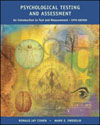Preface PART I: AN OVERVIEW 1.Psychological Testing and Assessment Testing and Assessment Who, What, and Why? Evaluating the Quality of Tests Close-Up Error of Measurement and the True Score Model Everyday Psychometrics Putting Tests to the Test Self-Assessment
2. Historical, Cultural, and Legal/Ethical Considerations An Historical Perspective Culture and Assessment Legal and Ethical Considerations Close-Up Life or Death Psychological Assessment Everyday Psychometrics Expert Testimony Self-Assessment
PART II: THE SCIENCE OF PSYCHOLOGICAL MEASUREMENT 3. A Statistics Refresher Scales of Measurement Describing Data The Normal Curve Standard Scores Close-Up The Normal Curve and Psychological Tests Everyday Psychometrics Consumer (of Graphed Data) Beware! Self-Assessment
4. Norms, Correlation, and Inference Norms Correlation and Regression Inference from Measurement Close-Up Almost Everything You May Want to Know About the Development
of the Pearson Everyday Psychometrics Good Ol’ Norms and the GRE Self-Assessment
5. Reliability The Concept of Reliability Reliability Estimates Using and Interpreting a Coefficient of Reliability Reliability and Individual Scores Close-Up The Reliability of the Bayley Scales for Infant Development
Everyday Psychometrics The Reliability Defense and the Breathalyzer
Test Self-Assessment
6. Validity The Concept of Validity Content Validity Criterion-Related Validity Construct Validity Validity, Bias, and Fairness Close-Up >Base Rates and Predictive Validity Everyday Psychometrics Adjustment of Test Scores by Group Membership:
Fairness in Testing or Foul Play? Self-Assessment
7. Test Development Test Conceptualization Test Construction Test Tryout Item Analysis Test Revision Close-Up Anatomy of the Development of a Test: The Personality Research
Form Everyday Psychometrics Psychometrics in the Classroom Self-Assessment
PART III: THE ASSESSMENT OF INTELLIGENCE 8. Intelligence and Its Measurement What Is Intelligence? Measuring Intelligence Intelligence: Some Issues A Perspective Everyday Psychometrics The Bell Curve Controversy Close-Up Culture-Fair/Culture-Loaded Self-Assessment
9. Tests of Intelligence The Stanford-Binet: Fourth Edition The Wechsler Tests Other Measures of Intelligence Close-Up How We Used Confirmatory Factor Analysis to Test the Structure
of the WISC-III, by Timothy Z. Keith, Ph.D. and E. Lea Witta, Ph.D. Everyday Psychometrics The Armed Services Vocational Aptitude Battery
(ASVAB): A Test You Can Take Self-Assessment
10. Preschool and Educational Assessment Preschool Assessment Achievement Tests Aptitude Tests Diagnostic Tests Psychoeducational Test Batteries Other Tools of Assessment in Educational Settings Close-Up >Tests of Minimum Competency Everyday Psychometrics Adapting to Adaptive Testing: The Case of
the GRE Self-Assessment
PART IV: THE ASSESSMENT OF PERSONALITY 11. Personality Assessment: An Overview Personality and Personality Assessment Defined Personality Assessment: Some Basic Questions Personality Assessment and Culture Tools of Test Development Issues and Trends in Personality Assessment Close-Up The Revised NEO Personality Inventory (NEO-PI-R), by Paul
T. Costa, Jr., Ph.D. and Robert R. McCrae, Ph.D. Everyday Psychometrics Assessing Acculturation and Related Variables
Self-Assessment
12. Personality Assessment Methods Objective Methods Projective Methods Behavioral Assessment Methods A Perspective Close-Up Developing Norms for a Projective Test, by Glen Roberts,
Ph.D. Everyday Psychometrics Confessions of a Behavior Rater Self-Assessment
PART V: TESTING AND ASSESSMENT IN ACTION 13. Clinical and Counseling Assessment An Overview The Interview Case History Data Psychological Tests Special Applications of Clinical Measures The Psychological Report Close-Up The DSM-IV Everyday Psychometrics Assessment of Dangerousness and the Secret
Service
14. Neuropsychological Assessment The Nervous System and Behavior The Neuropsychological Examination Tools of Neuropsychological Assessment Neuropsychological Test Batteries A Perspective Close-Up The Daubert Standard and Fixed Versus Flexible Neuropsychological
Test Batteries
15. The Assessment of People with Disabilities An Overview Assessment and Specific Disabilities Disability as a Diversity Issue Close-Up A Modest Proposal for a Model Form Everyday Psychometrics Public Law 105-17 and Everyday Practice Self-Assessment
16. Assessment, Careers, and Business Career Counseling Screening, Selection, Classification, and Placement Assessment of Productivity, Motivation, and Attitude Other Applications of Assessment Close-Up Validity Generalization and the GATB Everyday Psychometrics Designing Survey Research Questionnaires Self-Assessment
17. Computer-Assisted Psychological Assessment An Overview Computer Input Computer Output Issues in CAPA Close-Up Designing an Item Bank Everyday Psychometrics Computer-Assisted Behavioral Assessment
References Credits Name Index Subject Index | 


 2002 McGraw-Hill Higher Education
2002 McGraw-Hill Higher Education